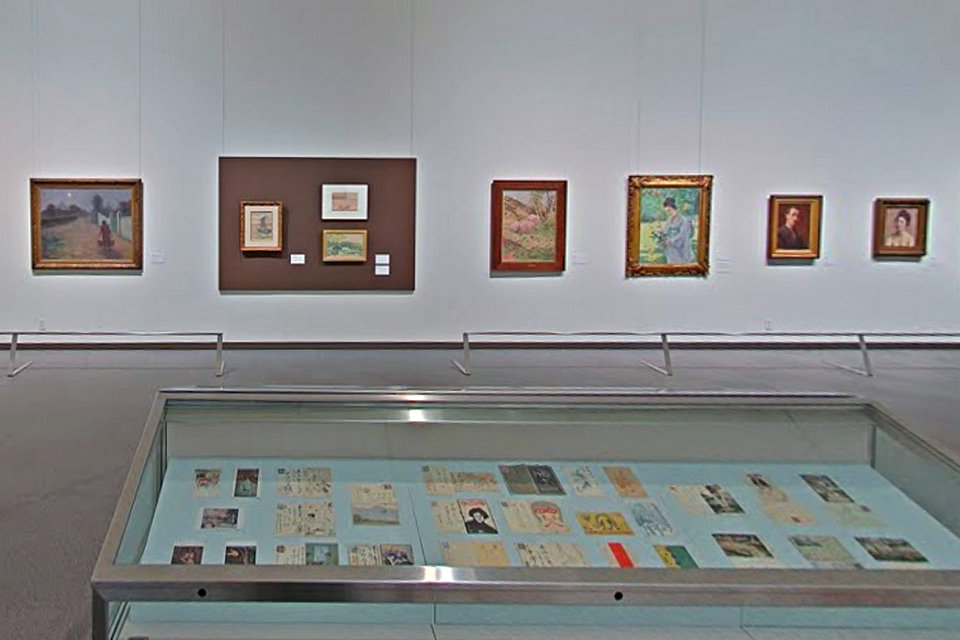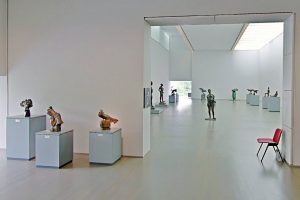Hiromitsu Nakazawa (中澤弘光 1874-1964) is a western painter, printmaker, oil painter and illustration artist. Former member of the Japan Art Academy. A painter who played an active part in Japanese Western style paintings from the Meiji era to the Showa era.
Nakazawa was born in 1874 in Shiba, Tokyo, to the house of the former lord of the Sadowara Hyuga Sadohara, and when he was young, lost his parents and was raised with a strict grandmother. After studying at a painting school by Yukihiko Soyama and Masaaki Horie, who specialize in painting, he enrolled in the Western Painting Course at the Tokyo School of the Arts in 1896 (Meiji 29), where he studied under Kiyoki Kuroda. While studying at Kuroda, he worked mainly on Hakubakai while learning a new expression of outside light under Kuroda. Eventually, when the Ministry of Education Art Exhibition (Bunbunten) was opened in 1907 (Meiji 40), he continued to exhibit and receive awards from the first exhibition, establishing a solid position as a Western painter. After forming Kofu-kai with Katsumi Miyake and Nonmizu Sugiura in 1911 (Meiji 44), he founded the Japan Watercolor Painting Society and Hakubi-kai, and worked vigorously. And in 1957 he was named a Cultural Meritor for his long-standing achievements.
Nakazawa was both a western painter and an excellent designer. With an outstanding sense of design, he quickly introduced Art Nouveau in Europe and has worked on books and illustrations for various books, including books written by Hiroshi Yosano (Tetsumi) and Akiko, as well as cover art for magazines. Nakazawa, who loves to travel, has included the good old scenery of Japan in art books and travelogues. In addition to oil paintings, there are many sketches and watercolors of travel.
After Nakazawa died in 1964, his atelier had been carefully preserved as it was when the painter was producing it. The atelier’s research revealed many valuable materials, including unpublished works and letters, and antiques collected by Nakazawa. This exhibition is the first major retrospective exhibition that illuminates the unknown aspects of Hiromitsu Nakazawa based on surveys and traces the entire picture of the painting business through oil paintings, watercolors, sketches, and book bindings, including masterpieces.
Chapter 1 History as a Western Painter
“I think that only one square is needed in a square measure, I know myself well. Today, three teachers are in order, that is, Ohno has bones, Thanks to Horie-sensei’s meat and Prof. Kuroda’s finishing, I think that the genius is somehow coming here, and the fact that my seniors were there I think it’s bald. ”
Hiromitsu Nakazawa, who contributed to the Japanese painting world through the Meiji, Taisho and Showa eras. Although his parents died early, his career as a western painter was blessed. From his early teens, he learned the basics of Western painting at an art school from a technical school called Soriyama (Ono) and Masaaki Horie, relying on his acquaintances in Kagoshima, where he studied Saburosuke Okada (1869-1939) and Eisaku Wada (1874-1959) and others. In 1896 (Meiji 29), the year of enrollment at the Tokyo Art School as a fourth year student coincided with the founding of the Hakubakai, and under the guidance of Kiyoki Kuroda, the place of presentation also moved from the Meiji Art Association to the Hakubakai. Was. Later, while developing other talents in work such as bookbinding, illustrations, and travelogues, he won numerous awards at the Ministry of Education Art Exhibition, which began in 1907, and became a judge. Nakazawa, who inherited Kuroda’s Sotokoku expression on the basis of solid expression, had a lyrical and aesthetic expression of his own, but in the Taisho era he used vivid colors. The various attempts, such as showing a political tendency, cannot be overlooked. Nakazawa, who started the Kofukai, the Japan Watercolor Painting Association, and the White Day Association with volunteers after moving to Europe at the age of 48 from the end of the Meiji era, continued to vigorously publish his works throughout his life.
Chapter 2 Work of designer Hiromitsu Nakazawa
In the Meiji period, when printing technology achieved remarkable development, newspapers and magazines were born as new media, and book binding changed drastically to Western paper and Western bindings from the West. Illustrations attached to type become indispensable with the development of technology, and Western painters will be mainly in charge of the paintings from the Meiji era. Around the same time, Art Nouveau reached its heyday in Europe, and painters and writers who traveled brought various materials, such as catalogs, magazines and posters, back to Japan. It is said that the materials related to Art Nouveau brought about by Soseki Natsume, who studied in London, and Kiyoki Kuroda, who went to the Paris International Exposition in 1900 (Meiji 33), had a great influence on Japanese painters. Hiromitsu Nakazawa and other Western painters will quickly grasp this new trend of art and create excellent graphic designs by book binding and magazine illustrations.
Nakazawa wrote an illustration of Art Nouveau as early as possible in the magazine “Meisei” sponsored by Tetsumi Yosano. While working on many designs for the works of Akiko Yosano, the wife of the Iron Trunk, she has developed her design talent. In Akiko’s masterpiece, The New Translation of The Tale of Genji, he is a Western painter who challenges Genji painting and completes a unique Nakazawa design that is different from Art Nouveau. Nakazawa was in charge of many bindings in addition to Yosano’s work, and in magazines he painted various cover arts and front-panels, mainly in literary magazines such as “Junior High School World” and “New Novel.” The design work that continued until the Showa era was numerous, ranging from books and magazines to newspaper illustrations, postcards, and posters. By revisiting the whole picture again, the excellent skills and achievements of “designer” Hiromitsu Nakazawa will become clear.
Chapter 3 Journey of Recollection
Hiromitsu Nakazawa was a painter who spent most of his 90-year life traveling.
Nakazawa first published landscape paintings of Kyoto and Nara in 1895 (Meiji 28), shortly after the Tokaido Main Line was opened. His journey began almost at the same time that the country’s railway network was established. And that became Nakazawa’s painting life itself.
The places we visited range from Aomori, the northernmost point of Honshu, to Shikoku and Kyushu, with Kansai as the lead.
For Nakazawa, who was born in Tokyo, the Buddhist temples in the region, which retain the taste of Edo and the Meiji era, were an attractive theme that sparked their will to create. He traveled not only to famous sightseeing spots, but also to remote mountainous areas and coastal areas, where he painted many of the casual scenery seen during his journey and the beauty of Japan that changes from season to season. Her works include travelogues such as “Japan’s famous scenic sketches of travel” (B-92-94, 98, 99) and “Kinai sightseeing” (B-95-97), and “Nihon Taikan” (work B-101). The book was published in woodblock prints such as “The 33 Country Pilgrimages of the West” (B-104), and gained popularity and made the name of landscape painter Hiromitsu Nakazawa widely known to the world.
And another major motif of Nakazawa obtained from the trip is Maiko.
In 1903 (Meiji 36), he began painting in Kyoto with Saburosuke Okada, and then went to Kyoto frequently, and later, along with the Japanese painter Mutsuen Tsuchida, became more and more called a “maiko painter”. And the work of geisha. Also, for Nakazawa, who continues his journey, healing and above all, hot springs all over Japan have been an attractive theme. The scenery of the hot spring area, the appearance of a woman immersed in hot water, and the customs of the spa are often illustrated.
During his travels, Nakazawa traveled around the antique shop, which was an easy time between productions, and collected antiques and souvenirs found not only in Japan but also in Europe, Korea, China and elsewhere. They were placed in ateliers and homes, and were often used as backgrounds for portraits during times of inability to travel freely, such as during wartime. These are also valuable materials that show the footprints of travel artist Nakazawa.
Until the last year of his 90th birthday, Nakazawa’s journey continued, and when he suddenly became ill and was hospitalized, he died as if he were aged. The surviving works tell the story of the artist’s journey and his life.
Mie Prefectural Museum of Art
Mie Prefectural Art Museum is an art museum located in Tsu City, Mie Prefecture. The museum opened in 1982 as the first full-scale art museum in the Chubu and Tokai districts. In 2003, the Yanagihara Yoshida Memorial Hall was opened. The collection of modern Japanese Western paintings is substantial.
The hallmark of the museum is that it is not just an ivory tower, it always seeks to work with society.
We carry out public relations activities for planning exhibitions, art lectures, gallery talks and art seminars, mobile museums for people in remote areas, and the publication of museum news “HILL WIND”.
The most noticeable result of museum activity is in exhibiting works. The real value of a museum, in particular, is due to its permanent exhibits. The permanent exhibition in the main building is divided into four periods a year, aiming to systematically capture the flow of art from the present to the present, with a focus on modern Japanese painting. The special exhibition room holds independent exhibitions based on unique themes and joint exhibitions from a broader perspective.




